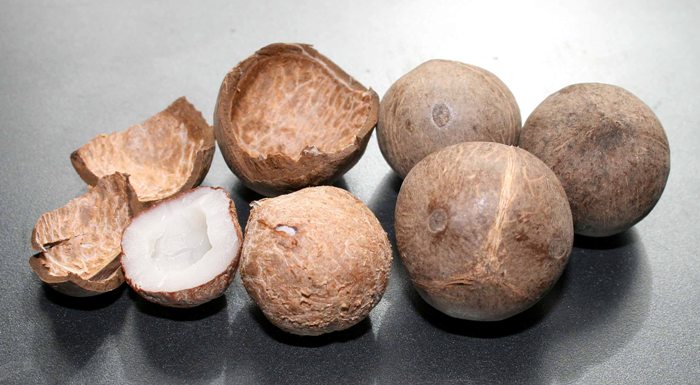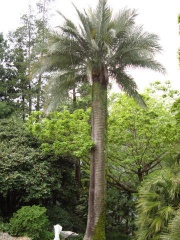- Erodium cicutarium (introduced weed from Europe)
- Porlieria chilensis (acacia like native shrub)
- Baccharis species (native shrub)
- grasses (e.g. Bromus, Stipa etc.)
In past the Chilean wine palm (Jubaea chilensis) was a wide spread species building large palm forests. Nowadays it's a threatened species and only small forest paches could survive (Gonzalez et al. 2009). One of them is in Ocoa, near Santiago de Chile. Here the degus feed on the nuts of this palm, the so called "coquitos". They are used as energy rich staple food and as reserve for the dry months. I tested this nut and the degus liked it.
The coquitos (they are really little cocosnuts):

Btw. the taste remembers also to the cocosnuts (I had to taste it of course
And the palm:

The photo is from Switzerland. The palms grow here in parks in the mediterranean like southern part near the frontier to Italy.
Suitability as animal food:
In wild the nuts are used by cururos (Spalacopus cyanus, rarely also kept as pet), degus, olive grass mice (Abrothrix olivaceus) and Bennet chinchilla rat (Abrocoma bennetti). In addition also the introduced ship rats (Rattus rattus) feeding on this nuts and they are also heavily harvested by humans. The shell of the nuts is thick and hard, but the degus are used to crack them, also domestic rats (Rattus norvegicus) learn quickly to crack them (here the proof: cracked nuts - the left nut is a coquito and right a macadamia).
Nutritional content:
The nuts contain 3,5 % water, 7,0 % protein, 67,3 % fat, 11,6 % crude fiber und 1,1 % minerals (Masson et al. 2008).
References and selected literature
Gonzalez et al. (2009): Ecology and Management of the Chilean Palm (Jubaea chilensis): History, Current Situation and Perspectives. Palms 53(2): 68-74.
http://www.captura.uchile.cl/jspui/handle/2250/10563
Masson, L. Camilo, C. M. Torija, M.E. (2008): Caracterización del aceite de coquito de palma chilena (Jubaea chilensis). Grasas y Aceites 59(1): 33-38. doi:10.3989/gya.2008.v59.i1.487
Meserve, P.L. 1981. Trophic relationships among small mammals in a Chilean semiarid thorn scrub community. Journal of Mammalogy 62: 304-314.
Meserve, P.L. Martin, R.E. Rodriguez, J. 1983. Feeding ecology of two Chilean caviomorphs in a central mediterranean savanna. Journal of Mammalogy 64: 322-325.
Zunino, S. Saiz, F. (1991): Estructura y densidad poblacional de Octodon degus Mol. Studies on Neotropical Fauna and Environment 26(3): 143-148.
Additional information (in german) and photos:
http://www.degupedia.de/wiki/index.php/Coquito
Original thread / see also: http://deguworld.proboards.com/index.cg ... hread=8909
Here is another topic dealing with this topic:
http://www.chileflora.com/forumenglish/ ... f=6&t=3239
Statistik: Verfasst von davX — 23.12.2012, 04:38
]]>